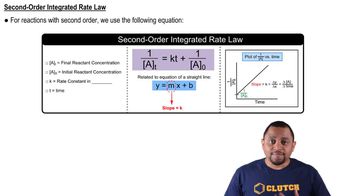Silver nitrate solutions are often used to plate silver onto other metals. What is the maximum amount of silver (in grams) that can be plated out of 4.8 L of an AgNO3 solution containing 3.4% Ag by mass? Assume that the density of the solution is 1.01 g/mL.
Ch.15 - Chemical Kinetics
Chapter 15, Problem 62a
The decomposition of XY is second order in XY and has a rate constant of 7.02⨉10-3 M-1• s-1 at a certain temperature. a. What is the half-life for this reaction at an initial concentration of 0.100 M?
 Verified step by step guidance
Verified step by step guidance1
Identify the order of the reaction. Since the decomposition of XY is second order, we will use the second-order half-life formula.
The formula for the half-life \( t_{1/2} \) of a second-order reaction is given by: \[ t_{1/2} = \frac{1}{k[A]_0} \] where \( k \) is the rate constant and \( [A]_0 \) is the initial concentration.
Substitute the given values into the formula: \( k = 7.02 \times 10^{-3} \text{ M}^{-1}\cdot\text{s}^{-1} \) and \( [A]_0 = 0.100 \text{ M} \).
Calculate the half-life using the substituted values. This will involve performing the division to find \( t_{1/2} \).
Interpret the result to understand the time it takes for the concentration of XY to decrease to half of its initial value at the given conditions.

Verified video answer for a similar problem:
This video solution was recommended by our tutors as helpful for the problem above.
Video duration:
1mWas this helpful?
Key Concepts
Here are the essential concepts you must grasp in order to answer the question correctly.
Second-Order Reactions
Second-order reactions are characterized by a rate that depends on the concentration of one reactant raised to the second power or on the concentrations of two reactants, each raised to the first power. The rate law for a second-order reaction can be expressed as rate = k[A]^2 or rate = k[A][B], where k is the rate constant. Understanding this concept is crucial for determining how the concentration of reactants affects the reaction rate.
Recommended video:
Guided course

Second-Order Reactions
Rate Constant (k)
The rate constant (k) is a proportionality factor in the rate law that is specific to a given reaction at a particular temperature. It provides insight into the speed of the reaction; a larger k indicates a faster reaction. For second-order reactions, the units of k are M<sup>-1</sup>•s<sup>-1</sup>, which reflects the relationship between concentration and time in the rate equation.
Recommended video:
Guided course

Equilibrium Constant K
Half-Life of a Reaction
The half-life of a reaction is the time required for the concentration of a reactant to decrease to half of its initial value. For second-order reactions, the half-life is inversely proportional to the initial concentration and can be calculated using the formula t<sub>1/2</sub> = 1/(k[A]₀), where [A]₀ is the initial concentration. This relationship is essential for predicting how long it will take for a reactant to diminish in concentration.
Recommended video:
Guided course

First-Order Half-Life
Related Practice
Textbook Question
Textbook Question
The half-life for the radioactive decay of U-238 is 4.5 billion years and is independent of initial concentration. How long will it take for 20% of the U-238 atoms in a sample of U-238 to decay?
Textbook Question
The half-life for the radioactive decay of U-238 is 4.5 billion years and is independent of initial concentration. If a sample of U-238 initially contained 3.2⨉1018 atoms when the universe was formed 13.8 billion years ago, how many U-238 atoms does it contain today?
Textbook Question
The half-life for the radioactive decay of C-14 is 5715 years and is independent of the initial concentration. How long does it take for 25.00% of the C-14 atoms in a sample of C-14 to decay?
